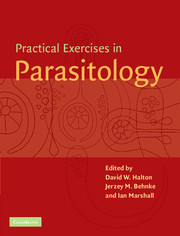Book contents
- Frontmatter
- Contents
- List of contributors
- Preface
- General advice
- 1 Observational Exercises on Parasites
- 2 Ecology
- 3 Physiology and Biochemistry
- 4 Pathology and Immunology
- 5 Chemotherapy
- 5.1 Sensitivity of a coccidial parasite, Eimeria, to an ionophore, monensin
- 5.2 Egg hatch assay for determination of resistance of nematodes to benzimidazole anthelmintics
- 5.3 Larval migration inhibition assay for determination of susceptibility of nematodes to levamisole
- 5.4 Effect of anthelmintics on nematodes
- 6 Molecular Parasitology
- 7 Behaviour
- Appendix 1 Reagent index
- Appendix 2 UK suppliers
- Appendix 3 US suppliers
- Index
5.2 - Egg hatch assay for determination of resistance of nematodes to benzimidazole anthelmintics
Published online by Cambridge University Press: 05 June 2012
- Frontmatter
- Contents
- List of contributors
- Preface
- General advice
- 1 Observational Exercises on Parasites
- 2 Ecology
- 3 Physiology and Biochemistry
- 4 Pathology and Immunology
- 5 Chemotherapy
- 5.1 Sensitivity of a coccidial parasite, Eimeria, to an ionophore, monensin
- 5.2 Egg hatch assay for determination of resistance of nematodes to benzimidazole anthelmintics
- 5.3 Larval migration inhibition assay for determination of susceptibility of nematodes to levamisole
- 5.4 Effect of anthelmintics on nematodes
- 6 Molecular Parasitology
- 7 Behaviour
- Appendix 1 Reagent index
- Appendix 2 UK suppliers
- Appendix 3 US suppliers
- Index
Summary
Aims and objectives
This exercise is designed to:
Determine the susceptibility of nematode eggs to treatment with a benzimidazole anthelmintic (thiabendazole; TBZ).
Introduction
The widespread use of anthelmintics to control gastrointestinal parasitism in sheep and goats has resulted in the emergence of strains resistant to the benzimidazole, levamisole or avermectin group of drug families. In some countries, multiple resistant strains have been selected. In the UK, the majority of cases of anthelmintic resistance are to the benzimidazole group, and an in vitro test for detection of resistant nematodes is based on the fact that benzimidazoles will inhibit the embryonation and hatching of fresh nematode eggs. The assay is based on the ovicidal properties of benzimidazoles and the ability of eggs from resistant strains to develop and hatch at higher concentrations of drug than that of susceptible strains.
The aim is to incubate fresh nematode eggs in serial concentrations of a benzimidazole anthelmintic, normally thiabendazole (TBZ). The percentage of eggs that hatch (or die) at each TBZ concentration is determined and a drug response curve plotted; i.e. drug concentration is plotted against percentage hatch (or death) of eggs, corrected for the normal mortality of untreated eggs. To obtain a linear regression from which to calculate the ED50 value (concentration of drug required to kill 50% of eggs) the data are usually transformed using arcsin or log-probit transformation.
- Type
- Chapter
- Information
- Practical Exercises in Parasitology , pp. 313 - 320Publisher: Cambridge University PressPrint publication year: 2001

